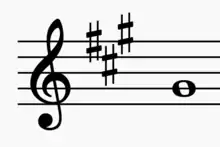G♯ (musical note)
G♯ (G-sharp) or sol dièse is the ninth semitone of the solfège. In the German pitch nomenclature, it is known as gis.[1]

G Sharp
It lies a chromatic semitone above G and a diatonic semitone below A, thus being enharmonic to la bémol or A♭ (A-flat).
When calculated in equal temperament with a reference of A above middle C as 440 Hz, the frequency of the G♯ semitone is approximately 415.305 Hz. See pitch (music) for a discussion of historical variations in frequency.
G♯/A♭ is the only note to have only one other enharmonic.
Designation by octave
| Scientific designation | Helmholtz designation | Octave name | Frequency (Hz) |
|---|---|---|---|
| G♯−1 | G♯͵͵͵ or ͵͵͵G♯ or GGGG♯ | Subsubcontra | 12.978 |
| G♯0 | G♯͵͵ or ͵͵G♯ or GGG♯ | Subcontra | 25.957 |
| G♯1 | G♯͵ or ͵G♯ or GG♯ | Contra | 51.913 |
| G♯2 | G♯ | Great | 103.826 |
| G♯3 | g♯ | Small | 207.652 |
| G♯4 | g♯′ | One-lined | 415.305 |
| G♯5 | g♯′′ | Two-lined | 830.609 |
| G♯6 | g♯′′′ | Three-lined | 1661.219 |
| G♯7 | g♯′′′′ | Four-lined | 3322.438 |
| G♯8 | g♯′′′′′ | Five-lined | 6644.875 |
| G♯9 | g♯′′′′′′ | Six-lined | 13289.75 |
| G♯10 | g♯′′′′′′′ | Seven-lined | 26579.501 |
Scales
Common scales beginning on G♯
- G♯ Major: G♯ A♯ B♯ C♯ D♯ E♯ F
 G♯
G♯ - G♯ Natural Minor: G♯ A♯ B C♯ D♯ E F♯ G♯
- G♯ Harmonic Minor: G♯ A♯ B C♯ D♯ E F
 G♯
G♯ - G♯ Melodic Minor Ascending: G♯ A♯ B C♯ D♯ E♯ F
 G♯
G♯ - G♯ Melodic Minor Descending: G♯ F♯ E D♯ C♯ B A♯ G♯
Jazz melodic minor
- G♯ Ascending Melodic Minor: G♯ A♯ B C♯ D♯ E♯ F
 G♯
G♯ - G♯ Dorian ♭2: G♯ A B C♯ D♯ E♯ F♯ G♯
- G♯ Lydian Augmented: G♯ A♯ B♯ C
 D
D E♯ F
E♯ F G♯
G♯ - G♯ Lydian Dominant: G♯ A♯ B♯ C
 D♯ E♯ F♯ G♯
D♯ E♯ F♯ G♯ - G♯ Mixolydian ♭6: G♯ A♯ B♯ C♯ D♯ E F♯ G♯
- G♯ Locrian ♮2: G♯ A♯ B C♯ D E F♯ G♯
- G♯ Altered: G♯ A B C D E F♯ G♯
References
- "The names of keys in English, French, German, Italian, and Spanish". Music Cataloging at Yale Language Tools. Yale University. Retrieved 2016-09-20.
This article is issued from Wikipedia. The text is licensed under Creative Commons - Attribution - Sharealike. Additional terms may apply for the media files.